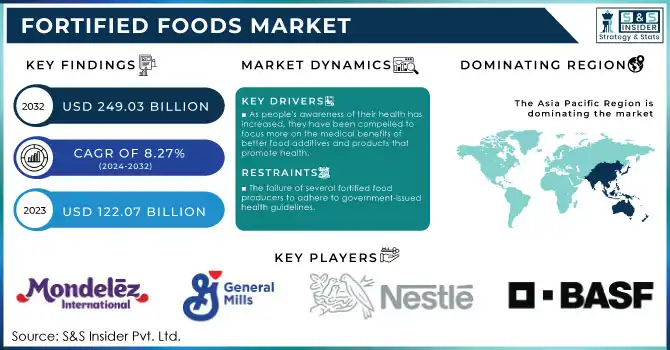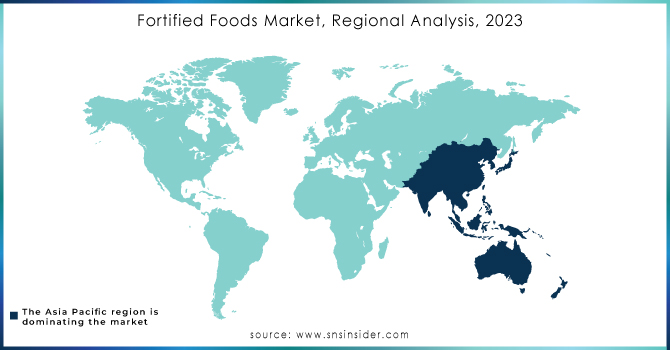Fortified Foods Market Report Scope & Overview:

Get E-PDF Sample Report on Fortified Foods Market - Request Sample Report
The Fortified Foods Market size was valued at USD 122.07 Billion in 2023 and is expected to reach USD 249.03 Billion by 2032 and grow at a CAGR of 8.27% over the forecast period of 2024-2032.
The worldwide Fortified food sources market has been an area of strength for seeing throughout recent years by expanding utilization of nutrient-enhanced food sources. Developing wellbeing concerns combined with expanding infection events are the key variables driving the fortified food varieties market over the following seven years. Expanding purchasers’ discretionary cash flow spurring them to spend more on quality food items is additionally expected to supplement the market development over the figure period. Braced food sources have therapeutic properties that give recuperating benefits separated from energy and fundamental supplements. Expanding interest in this classification of food varieties is additionally expected to support strengthened food interest over the estimated period. Attributable to enormous medical advantages, center enhancement clients are changing to Fortified food varieties throughout recent years. This change sought after towards sustained food varieties is supposed to flood the market development soon.
Sustained food sources can be fragmented into Vitamin D, folic corrosive, iron, and iodine, based on supplement organization. The greater part of the Fortified food varieties including ready-to-eat cereals, milk, yogurts, margarine, and other useful food sources containing vitamin D. Milk fortress program was carried out in numerous nations across the globe as would be considered normal to drive the market development throughout the following seven years. Fundamental strengthened food sources incorporate grains and cereal-based food varieties, milk and milk items, fats and oils, extra food varieties things, tea and different drinks, and newborn child equation. Stronghold of food varieties with these nutrients assists ladies with meeting supplement prerequisites during pregnancy and breastfeeding. This is additionally expected to drive the worldwide market over the following seven years.
Market Dynamics:
Driving Factors:
-
As people's awareness of their health has increased, they have been compelled to focus more on the medical benefits of better food additives and products that promote health.
-
The development of fresh collections of long-lasting food goods by the major industry competitors.
Major industry rivals have started working on the creation of creative collections of durable food products in response to changing customer needs and market trends. The two goals of prolonging product shelf life and maintaining nutritional quality and flavor are met by these collections. These businesses seek to provide customers practical, sustainable solutions that fit into contemporary lifestyles by utilising cutting-edge food preservation techniques including cutting-edge packaging technology and natural additives. These new collections of long-lasting food items address issues with food waste by establishing a balance between durability and quality, while also meeting the growing need for convenient but nourishing meals in a rapidly changing environment.
Opportunities:
-
Growing customer interest among wellness-conscious consumers.
-
To develop cutting-edge strength, players adopt item separation mechanisms.
Players are increasingly embracing item separation mechanisms as a key component of their training routines to develop cutting-edge strength. By isolating particular muscle groups or motions during exercises, this novel method enables targeted and rigorous growth. Athletes may improve their performance in a variety of sports and activities by concentrating on certain aspects of strength, such as explosive power or endurance. The use of item separation mechanisms, which include methods like isolation workouts, specialized tools, and functional training regimens, enables players to improve their general strength and target particular shortcomings. This approach emphasizes the increasing understanding of how muscles become stronger, emphasizing accuracy and adaptability to reach one's physical peak.
Challenges/Restraining Factors:
-
The failure of several fortified food producers to adhere to government-issued health guidelines.
-
Various regional dietary requirements and complicated restrictions.
Due to complex constraints and varied regional dietary needs, the market for fortified foods confronts difficulties. Manufacturers must traverse a challenging environment to create and sell fortified goods that are by local tastes and strict nutritional standards due to divergent cultural norms, health issues, and regulatory frameworks in various geographic areas. A considerable challenge is posed by tailoring formulations and labeling procedures to meet these specific demands; to assure compliance and customer approval in a worldwide market with a range of dietary needs and preferences, careful study and strategic planning are required.
Impact of COVID-19:
Purchasers are not generally fulfilled by organizations settling for the status quo. With expanding enhancement, straightforwardness, and item personalization, purchasers are picking those with demonstrated benefits that they can trust.
Additionally, customers are searching for long-haul benefits from the strengthened food sources. Customers go to lengths to safeguard their invulnerability by being more particular with what they eat. This to some extent makes sense of the ascent in superfoods and braced food varieties.
Accordingly, the above pattern was additionally advanced by the effect of COVID-19, as individuals from one side of the planet to the other are hoping to invigorate their insusceptible wellbeing before they can be powerless against any infection.
Impact of Ongoing Recession
Due to the recession's effects on the world's agricultural systems as well as other local shocks and stresses like war and climate change, food prices have increased.
The cost of the recommended diet climbed by 17.9%, largely in the past year as the cost of nutritious foods such fruit, vegetables, and legumes, as well as grains, healthy fats/oils, and meat/meat substitutes, rose by 12.8%. Contrarily, the price of the usual diet's harmful foods and beverages "only" grew by 9.0% from 2019 to 2022 and 7.0% from 2021 to 2022. The price of unhealthy takeaway food was an exception, which grew by 14.7% from 2019 to 2022.
Impact of Russia Ukraine War
Oil and natural products, such as fortified meals or very nutritious protein products, were most affected by the conflict between Russia and Ukraine. The largest producer of sunflower oil in the world is Ukraine. Together with Russia, it accounts for more than half of all vegetable oil exports worldwide. Additionally, the area exports 36% of the world's wheat. The supply of important essential goods has drastically decreased as a result of the war in Ukraine and the sanctions imposed on Russia. As a result, food costs have increased internationally.
Prices of Fortified commodities like soybeans and other vegetable oils increased by around 50% to 60% within a week after Russia entered eastern Ukraine in the early hours of February 24, 2022.
Market Estimations:
By Nutrient Composition:
The fortress is the expansion of key nutrients and minerals like iron, iodine, zinc, and Vitamin an and D to staple food sources like rice, milk, and salt to work on their wholesome substance. These supplements might have been initially present in the food before handling.
Food varieties are most frequently invigorated with multivalent cationic minerals, like calcium, iron, magnesium, and aluminum, and nutrients, similar to C, D, E, and B-complex. Even though certain medications ought not to be taken with stomach-settling agents, multivitamins, and mineral enhancements, many don't think about the ramifications of taking their everyday drugs with food. The ongoing Food and Drug Administration normalized feast utilized in item marking of medication food connections is a high-fat, unhealthy eating regimen that gives just a modest quantity of dietary nutrients and minerals.
Key Market Segmentation:
By Nutrient Composition:
-
Vitamins
-
Carbohydrates
-
Proteins
-
Minerals
-
Probiotics
-
Others
Regional Coverage
North America
- US
-
Canada
-
Mexico
Europe
-
Eastern Europe
-
Poland
-
Romania
-
Hungary
-
Turkey
-
Rest of Eastern Europe
-
-
Western Europe
-
Germany
-
France
-
UK
-
Italy
-
Spain
-
Netherlands
-
Switzerland
-
Austria
-
Rest of Western Europe
-
Asia Pacific
-
China
-
India
-
Japan
-
South Korea
-
Vietnam
-
Singapore
-
Australia
-
Rest of Asia Pacific
Middle East & Africa
-
Middle East
-
UAE
-
Egypt
-
Saudi Arabia
-
Qatar
-
Rest of Middle East
-
-
Africa
-
Nigeria
-
South Africa
-
Rest of Africa
-
Latin America
-
Brazil
-
Argentina
-
Colombia
-
Rest of Latin America
Locally, North America, Asia Pacific, Europe, Latin America, the Middle East, and Africa comprise the vital fragments in the worldwide braced food sources market. Among these locales, the market has been seeing exceptionally rewarding open doors in the Asia Pacific. The support got from the strengthened food varieties market by policymakers in China, combined with the developing well-being awareness among shoppers is helping the market's extension in the district. Other than this, the rising frequency of nearsightedness in grown-ups is supposed to drive the Asia Pacific braced food sources market. The organizations can likewise track down appealing open doors in India.
In North America and Europe, the market players are acquiring from the elevated degree of mindfulness and rising wellbeing mindfulness.

Get Customized Report as per your Business Requirement - Request For Customized Report
Key Players:
Nestlé S.A., BASF SE, General Mills, Tata Chemicals Limited, Mondelz International, Cargill Incorporated, Danone, Bühler AG, Bunge Limited, Unilever PLC.
Recent Development:
General Mills, a major participant in the lucrative industry for food fortification, has concentrated on enhancing the nutritional content of specific types of cereals, such as flour.
| Report Attributes | Details |
|---|---|
| Market Size in 2023 | US$ 122.07 Billion |
| Market Size by 2032 | US$ 249.03 Billion |
| CAGR | CAGR 8.27% From 2024 to 2032 |
| Base Year | 2023 |
| Forecast Period | 2024-2032 |
| Historical Data | 2020-2022 |
| Report Scope & Coverage | Market Size, Segments Analysis, Competitive Landscape, Regional Analysis, DROC & SWOT Analysis, Forecast Outlook |
| Key Segments | • by Nutrient Composition (Vitamins, Carbohydrates, Proteins, Minerals, Probiotics, and Others) • by Distribution Channel (Online, and Offline) |
| Regional Analysis/Coverage | North America (US, Canada, Mexico), Europe (Eastern Europe [Poland, Romania, Hungary, Turkey, Rest of Eastern Europe] Western Europe] Germany, France, UK, Italy, Spain, Netherlands, Switzerland, Austria, Rest of Western Europe]), Asia Pacific (China, India, Japan, South Korea, Vietnam, Singapore, Australia, Rest of Asia Pacific), Middle East & Africa (Middle East [UAE, Egypt, Saudi Arabia, Qatar, Rest of Middle East], Africa [Nigeria, South Africa, Rest of Africa], Latin America (Brazil, Argentina, Colombia Rest of Latin America) |
| Company Profiles | Nestlé S.A., BASF SE, General Mills, Tata Chemicals Limited, Mondelz International, Cargill Incorporated, Danone, Bühler AG, Bunge Limited, Unilever PLC |
| Drivers | • As people's awareness of their health has increased, they have been compelled to focus more on the medical benefits of better food additives and products that promote health. • The development of fresh collections of long-lasting food goods by the major industry competitors. |
| Market Opportunities | • Growing customer interest among wellness-conscious consumers. • To develop cutting-edge strength, players adopt item separation mechanisms. |

